Animal Behaviors: Japanese Village and Deer Park in Buena Park
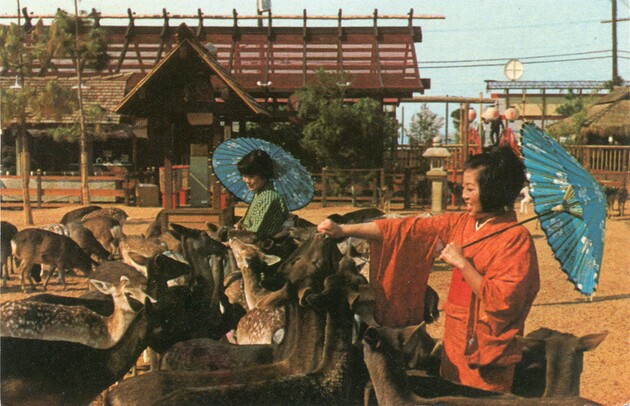
I am a sucker for fantasy. When I was an untraveled pre-teen, I went to an amusement park which featured a fake "Italian-style" city. As I sat on a cheesy, large fountain made of plaster, listening to a man with a faux mustache singing opera, I put down my cup of ten dollar "gelato" and nudged my friend. "There is no way real Italy can be as beautiful as this!" I exclaimed, with totally joyful sincerity.
Nothing is less fantastical than a charmless California park on an excruciatingly hot Wednesday afternoon. Last week, an older and more traveled me stood in the middle of the sparsely populated George Bellis Park in Buena Park. The Santa Ana Freeway was in full view. I scrutinized a vaguely whimsical but rundown lamppost that had seen better days, trying to determine if it was left over from Japanese Village and Deer Park -- an "enchanted village" patronized in the 1960s and '70s by thousands of urban Angelenos desperate for wildlife, trees, and fairytales. I passed a utilitarian playground where a weary-looking family of four stood listlessly, next to the swings but not on them. I passed what may be leftover concession stands, now boarded up, and lonely looking people eating lunch at covered picnic tables. I tried to determine if the various species of trees had been planted by the amusement park or by the state, and then I realized it didn't really matter.
I walked next door to the Village Business Park, which was built over part of the amusement park in the late '70s. The business park consists of bright white warehouses and office buildings. A couple of men and women dressed in grey walked by, not smiling, carrying lunch sacks. I found it all relentlessly grim. I wished this area was still purposed for second rate amusement -- with koi ponds, basketball playing bears, and deer running through a make-believe forest that defused the harsh California sun. But then I remembered the stories I had read about the deer's eventual fate. I remembered that animals used for human entertainment often have a distressing life. I guess what I really wanted was to escape. I got back in my sweltering car, turned on some country song about chilling at the beach with your crew, and pretended I was on a tropical island. I immediately felt much better.


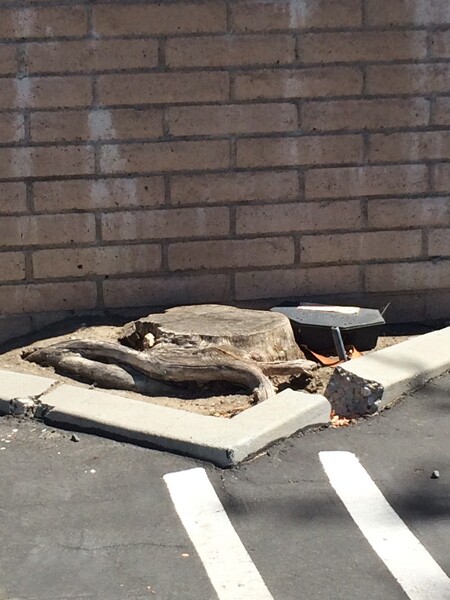

Authentically Costumed Kabuki
Where miniature deer eat from your hand, snowy pigeons and doves act like household pets and brown bears perform their comic antics-- Los Angeles Times, March 8, 1968 1
With buttons you can shape an animal's behavior just as a sculptor shapes clay.-- Los Angeles Times, June 16, 1970 2
Allen Parkinson was an idea man. After thumbing his way to California, the handsome and charismatic Idaho native worked for Mercury Records as a salesman. In the late 1950s, he developed Sleep-Eze, the antihistamine sleeping aid that launched a thousand imitators. After selling the company in 1959, Parkinson travelled to Europe with his daughter. A visit to Madame Tussaud's inspired him to open the Movieland Wax Museum in Buena Park in Orange County, in 1962. A few years later, a trip to Japan's famous Nara Deer Park led him to open the Japanese Village and Deer Park on 29 acres of land adjacent to the already successful Wax Museum.
When it opened in 1967, the "only authentic Japanese Village in the western hemisphere" 3 featured a herd of 200 exotic deer, and ducks, bears, black swans, and a dove pavilion. There was a Japanese teahouse, "vaguely" Japanese food, and an overwhelmingly Asian staff. A 2,500 seat aquatheater, believed to be "the largest inland artificial body of salt water in the world," was constructed in 1969. It was home to a water show with seals, dolphins, and "bears shipped to the village from Hokkaido, Japan." 4
The park was one of many already in the area. Orange County was fast becoming the "great American family fun zone," boasting amusements including Disneyland, Knott's Berry Farm, and Melodyland. 5 Parkinson explained that his park's location, just off the freeway, brought in increased business to the Japanese Village. A "Robot-San" samurai warrior, modeled after park announcer Masa Ikeda, greeted visitors near the pearl lagoon. Ikeda joked that the robot -- who was a few inches taller and could be programmed to speak any language -- prompted his co-workers to say, "they'd rather go out with him than me." 6 The Village offered these kinds of prosaic alternatives to the thrill rides and extreme attractions at other nearby amusements. The park's atmosphere drew rhapsodic praise from L.A. Times columnist Lois Dawn, who visited in 1970:
The buildings are as gay as the tilt of a dancers hand, the gardens a precise bow to the beauty of proportion, the fish, birds, animals are real and the performances are delightful. [There are] Japanese dancers, demonstrations of karate, performing chimpanzees, a bear that swings on a trapeze, and an enchanting dolphin that teases his lovely Japanese mermaid partner, dances with her, and leaps magnificently. The park is ingeniously arranged so that in the midst of a crowd you may wander alone. You may go with everyone in the enclosure with the deer, tame enough not only to eat from your hands but also to nibble your coat...The long system of pools where the off-stage dolphins practice swimming and roll over to show you their wise, sensible, comical faces will also seem like your own private discovery. There are shops, glass blowers, shrines, banners, lanterns-and you may buy an oyster guaranteed to have a pearl for $2.85. The tea ceremony is performed every hour in a tiny garden with tree trunks to sit on and a pretty girl to explain over an out of place microphone. 7
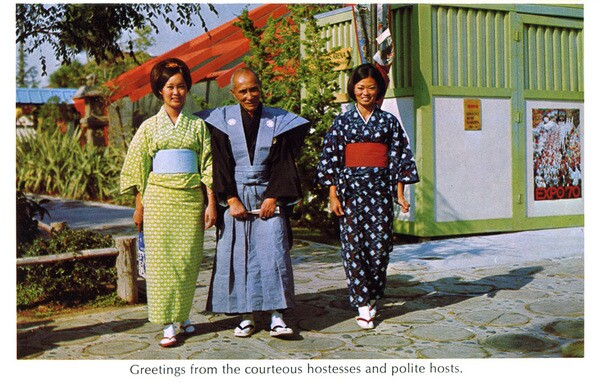
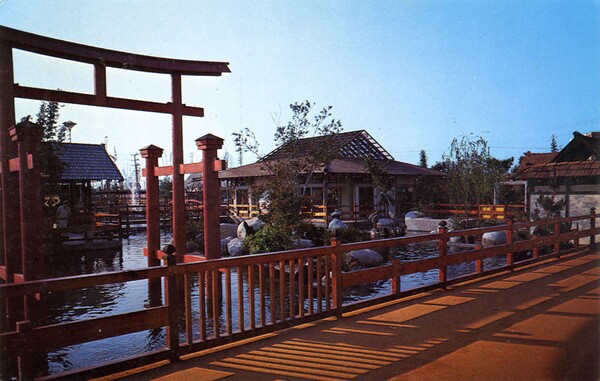
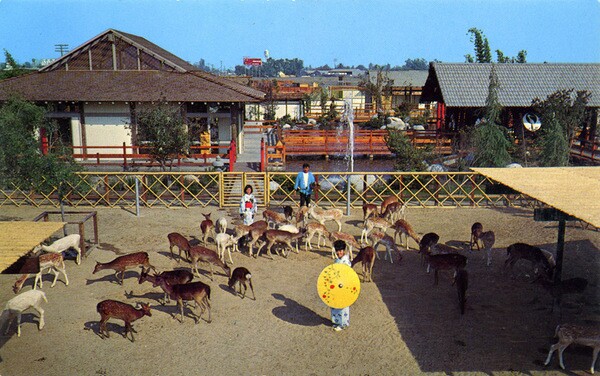
Hundreds of animals called the park home. There was Gunta, the 450 pound somersaulting bear, Newtka the killer whale, and Madras the Bengal tiger, to name a few. They worked in front of audiences most days of the week. The bears played basketball, clapping after each basket. Big Ben, a macaw, roller skated across a platform while his fellow macaw Mumbles did a high-wire bicycle act. Old Gold, the 50 year-old, $700 koi fish, played poker (by swimming to certain cards) with audience members, winning upward of 90% of the time 8
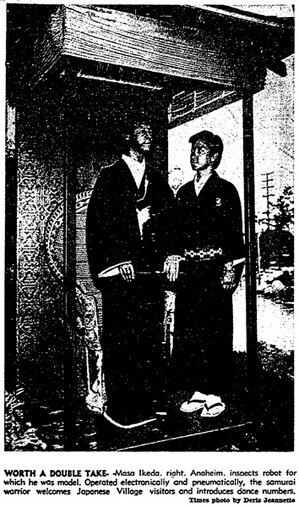
Parkinson hired trainers like Don Smith, "The Dr. Doolittle of Japanese Village," and his wife, Becky. 9 One of his employees was a man named Silverio Nieto, an illiterate Mexican immigrant whose gentle, intuitive way with animals made him a park legend. The trainers used new training methods based on rewarding and encouraging animals instead of using the old methods of fear, pain, and punishment. Smith used a technique developed by Dr. B.F. Skinner called "operant conditioning," which he directed from "an electronic console behind barred doors and a heavy glass window." 10 "It's really quite simple," Smith explained, "you give the animal a job to do, let him figure out how to do it and reward him when he does it. Animals are quick to learn what behavior or trick results in a reward. They'll work like heck. Food is their god, but they also get an electronic tone that means well done for reinforcement." 11
In 1970, "for reasons of health," Parkinson sold the Japanese Village and Deer Park, and Movieland Wax Museum, to Great Southwest Co., a subsidiary of Six Flags Inc. The park continued much as before until 1974, when a "historic lack of attendance" persuaded the management to close the park. According to the L.A. Times,
Closing of the park just as the Christmas season is getting under way had a gloomy effect on the few employees still working Tuesday. They went about their duties almost silently. At a food pavilion, chairs and benches were piled atop tables. In another area, benches once reserved for tourists were taken over by flocks of doves and pigeons. On a stage where acrobats and karate teams had performed, there was only stillness and an air of loneliness. In the deer pens, once a favorite of children, the animals quietly grazed. 12
The Gentle Jungle
Sponsors call it a gentle jungle because the exotic creatures have been taught not to feed -- or feed on -- the human beings-- Los Angeles Times, June 27, 1976 13
Thus began the darkest chapter of the park's history. Though the public was reassured that all the animals would be cared for at the park until they found a new, safe home -- that does not appear to be what happened. At some point after the parks closure, some of the park's deer "were sent to UC Davis for use in a $50,000 tuberculosis study, and others were destroyed after tests indicated that some of the animals had positive reactions to the TB tests." 14 According to the L.A. Times, gentle Silverio was the one who had to lasso some of the exposed deer so that they could be put down. There were also reports that before the park had closed, animals had been malnourished, and a tiger had mauled a guard. Due in part to these disturbing stories, the park sat empty for two years.
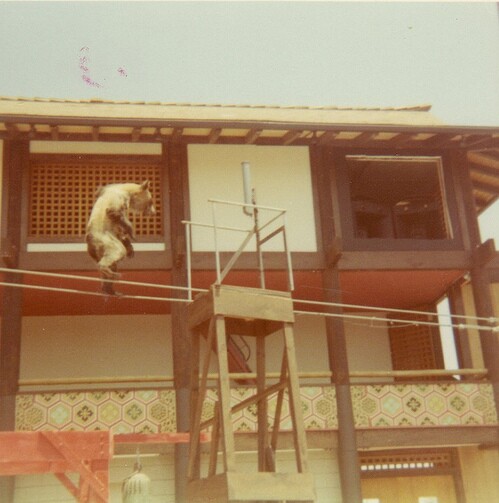
Bear and Karate Theatre at Japanese Village and Deer Park, 1971 | Photo: Jasperdo/Flickr/Creative Commons
In February 1976, the park was bought by Enchanted Village Inc., and headed by Ralph Helfer, a Hollywood animal trainer who founded the "affection training method of communicating through mutual love, respect and understanding." 15 By May 1976, one hundred men were working on the new attraction, which would include "several hundred animals and a bridge of enchantment which leads visitors to exhibits and attractions." 16 When the "Enchanted Village opened in June 1976, the L.A. Times reported:
Tropical birds, mysterious sounds, sudden, exotic mists [...] At night, thanks to accent lighting, the gentle jungle becomes even more dramatic. The trail leads over the bridge of enchantment. Wind chimes and incense reinforce the magical feeling. Finally, one encounters the personification of the gentle jungle-in bronze -- a majestic lion and his lamb. In the outdoor gentle jungle theater there are demonstrations of what affection training is all about. Shows recreate many of the most spectacular moments from great animal films and will add a few new ones as well: a man being stalked and attacked by a leopard; a bear being wrestled; an ostrich being ridden. The bicentennial tribute to animals is in the 3000 seat theater. It is a tribute to the great animals of America features horses eagles snakes and bears -- along with human singers and dancers. 17
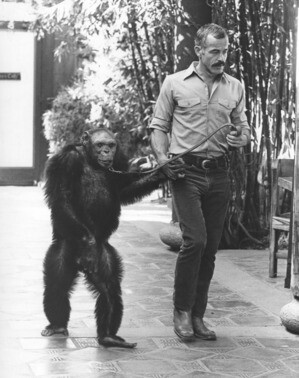
Herald-Examiner Collection, Los Angeles Public Library
Costing less per person than a first run movie, the Enchanted Village had a decidedly '70s, hippie vibe. There were a number of "happenings" throughout the park. They included "a beautiful girl playing a guitar and singing on a grassy knoll with an enormous lion lying like a kitten at her feet, a man covered with tarantulas, or even a girl entangled by a 75 pound python." 18 Children could pet goats and tortoises at "touching places." However, there were no deer lest the new park be associated with the old park's sins. At the "non-shooting gallery" guests could take pictures of rotating wildlife. Hefler's wife, Toni, led curious journalists through the park while "nuzzling a timber wolf and flirting with a lion and a Tiger named Patty Cake." 19
Journalists were most eager to meet Oliver, a South African primate, whose upright walk and human behaviors (including crying, smoking and a strong attraction to human ladies) led many to incorrectly believe he may be "the missing link." Dubbed a "humanzee," Oliver was already a national star when he arrived at the Enchanted Village. He performed three times a day and "never got stage fright." 20 But even Oliver's star power could not make the Enchanted Village a financial success. The Village went into bankruptcy and closed in 1978. Helfer moved his animals to the OC fairgrounds. Sadly, Oliver passed from trainer to trainer, and then to an experimentation lab where he was kept in a small cage for years. He was finally rescued and spent his old age at an animal sanctuary, dying in 2012.
No More Magic
In July of 1979, ground was broken on the Village Business and Industrial Center, where the amusement parks used to stand. The park's design allegedly followed "a European plan," though its effect is not evident at the visually style-less office park all these years later. In 1986, a group of over 300 former Japanese Village employees attended a reunion organized by Darlene Yoshikwa. "We all hugged each other," Darlene said, "it was heartwarming." 21 I guess that is the best kind of magic there is, and it is 100% real.
_____
1 Los Angeles Times, March 8, 1968
2 "Pushbuttons teach animals" Los Angeles Times, June 16, 1970
3 "Aquatheater" Los Angeles Times, May 18, 1969
4 "Calendar" Los Angeles Times, October 15, 1967
5 "OC Tourism" Los Angeles Times, October, 1973
6 "Robot" Los Angeles Times, August 2, 1970
7 "Roundabout" by Lois Dawn, Los Angeles Times, December 4, 1970
8 "There's a Catch" Los Angeles Times, March 26, 1972
9 Ibid.
10 "Pushbuttons teach animals" Los Angeles Times, June 16, 1970
11 "On training animals" Los Angeles Times, August 22, 1969
12 "Japanese Village theme park in Orange County shuts down" Los Angeles Times, December 4, 1974
13 "Mingling with wildlife in gentle jungle" Los Angeles Times, June 27, 1976
14 "Deer Park was empty" Los Angeles Times, February 4, 1976
15 "New family attraction" Los Angeles Times, June 11, 1976
16 Ibid.
17 Ibid.
17 Ibid.
19 "Mingling with wildlife in gentle jungle" Los Angeles Times, June 27, 1976
20 "Olive is enough to drive an anthropologist bananas" Los Angeles Times, January 26, 1977
21 "People" Los Angeles Times, September 2, 1986